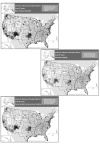Using GIS in a first national mapping of functional disability among older American Indians and Alaska Natives from the 2000 census
- PMID: 16948854
- PMCID: PMC1590018
- DOI: 10.1186/1476-072X-5-37
Using GIS in a first national mapping of functional disability among older American Indians and Alaska Natives from the 2000 census
Abstract
Background: Geographical information systems (GIS) have been used mainly in understanding infectious diseases and environmental threats in health research. Here, GIS was used to examine patterns of functional disability as one impact of chronic disease in American Indians and Alaska Natives. The study purpose was to create the first national mapping of functional disability for AIANs using the 2000 U.S. Census.
Results: American Indians and Alaska Natives over age 65 reported disability at a rate of 57.6% versus 41.9% for all people over 65 (P < or = 0.0001). Regional differences in levels and type of disability were evident.
Conclusion: Maps help visualize those who might otherwise be 'lost' from the data. The significance of this study is that gerontologic programs and policies are data-driven, yet there is a lack of reliable national level data from US health systems on functional disability among American Indians and Alaska Natives. One study limitation was that Census questions regarding disability differed from traditional measures of activities of daily living and instrumental activities of daily living. An immediate policy recommendation would be to incorporate standard activities of daily living and instrumental activities of daily living language into future Census for a comprehensive, linked database for the future.
Figures





Similar articles
-
Functional limitations among older American Indians and Alaska natives: findings from the census 2000 supplementary survey.Am J Public Health. 2005 Nov;95(11):1945-8. doi: 10.2105/AJPH.2004.053462. Epub 2005 Sep 29. Am J Public Health. 2005. PMID: 16195521 Free PMC article.
-
Cardiovascular health among American Indians and Alaska Natives: successes, challenges, and potentials.Am J Prev Med. 2005 Dec;29(5 Suppl 1):11-7. doi: 10.1016/j.amepre.2005.07.023. Am J Prev Med. 2005. PMID: 16389120
-
Collecting information on disability in the 2000 Census: an example of interagency cooperation.Soc Secur Bull. 1999;62(4):21-30. Soc Secur Bull. 1999. PMID: 10769869
-
Nutrition in American Indian health: past, present, and future.J Am Diet Assoc. 1986 Nov;86(11):1561-5. J Am Diet Assoc. 1986. PMID: 3534063 Review.
-
American Indians and Alaska Natives--overview of the population.Public Health Rep. 1996;111 Suppl 2(Suppl 2):49-50. Public Health Rep. 1996. PMID: 8898774 Free PMC article. Review.
Cited by
-
Role of remote sensing, geographical information system (GIS) and bioinformatics in kala-azar epidemiology.J Biomed Res. 2011 Nov;25(6):373-84. doi: 10.1016/S1674-8301(11)60050-X. J Biomed Res. 2011. PMID: 23554714 Free PMC article.
-
Ageing, the urban-rural gap and disability trends: 19 years of experience in China - 1987 to 2006.PLoS One. 2010 Aug 13;5(8):e12129. doi: 10.1371/journal.pone.0012129. PLoS One. 2010. PMID: 20730089 Free PMC article.
-
Lower body functioning and correlates among older American Indians: The Cerebrovascular Disease and Its Consequences in American Indians Study.BMC Geriatr. 2018 Jan 5;18(1):6. doi: 10.1186/s12877-017-0697-8. BMC Geriatr. 2018. PMID: 29304750 Free PMC article.
-
Unmet Assistance Need Among Older American Indians: The Native Elder Care Study.Gerontologist. 2015 Dec;55(6):920-8. doi: 10.1093/geront/gnt211. Epub 2014 Jan 22. Gerontologist. 2015. PMID: 24451895 Free PMC article.
-
Association of depressive symptomatology with receipt of informal caregiving among older American Indians: the native elder care study.Am J Geriatr Psychiatry. 2015 Jun;23(6):579-88. doi: 10.1016/j.jagp.2014.03.013. Epub 2014 Apr 5. Am J Geriatr Psychiatry. 2015. PMID: 24801609 Free PMC article.
References
-
- Brown M, Eccles C, Wallis MG. Geographical distribution of breast cancers on the mammogram: an interval cancer database. Br J Radiol. 2001;74:317–322. - PubMed
MeSH terms
LinkOut - more resources
Full Text Sources
Medical

